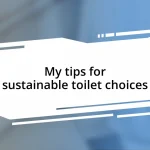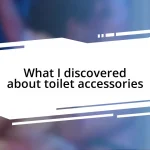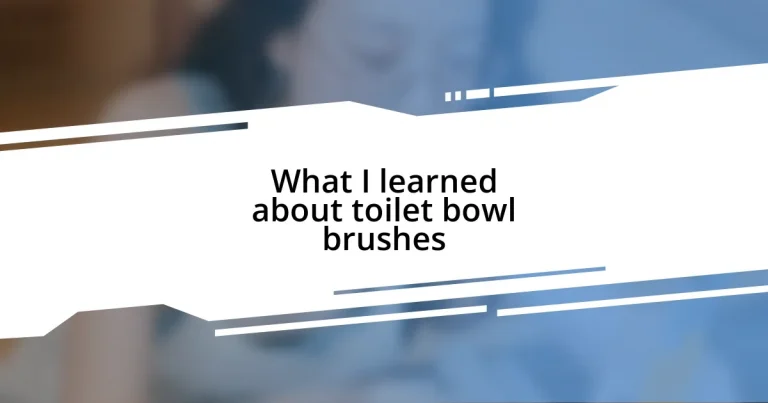Key takeaways:
- Different types of toilet bowl brushes exist, including traditional bristle, silicone, disposable, and electric options, each with unique benefits.
- Effective brushes should feature sturdy bristles, ergonomic handles, durable materials, quick-drying holders, and ease of cleaning.
- Regular maintenance of toilet brushes, including rinsing, holder cleaning, and timely replacement, is essential for hygiene and longevity.
- Eco-friendly alternatives, such as biodegradable brushes and repurposed items, offer sustainable cleaning options without sacrificing effectiveness.
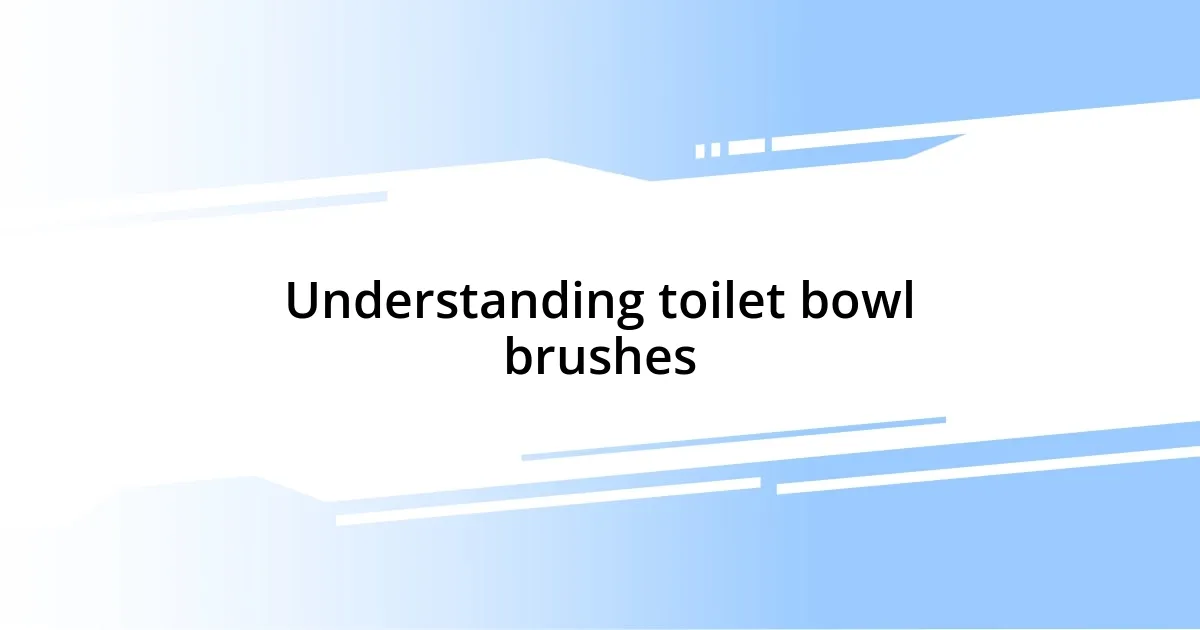
Understanding toilet bowl brushes
Toilet bowl brushes might seem like a mundane household item, but understanding their design and functionality can significantly enhance our cleaning routine. I remember the first time I realized the importance of the brush’s bristles; they varied so much, and I found that stiffer bristles do a better job at tackling hard-to-reach stains. Have you ever felt the frustration of using a brush that just slides over grime instead of really cleaning?
One thing I’ve learned is that not all toilet brushes are created equal. Certain materials, like nylon, are durable and resistant to bacteria, while others can harbor germs and odors if not cleaned properly. This realization hit me one day when I paused to clean my brush—it’s easy to forget that we need to maintain the tool that keeps our toilets fresh.
Additionally, the storage of toilet bowl brushes plays a crucial role in hygiene. For instance, I used to leave my brush in its holder, assuming it would dry out there, but I discovered that a vented holder helps prevent the buildup of moisture. Have you ever considered how the way we store our cleaning tools affects overall bathroom cleanliness? It’s these small details that often make the biggest difference in maintaining a fresh space.
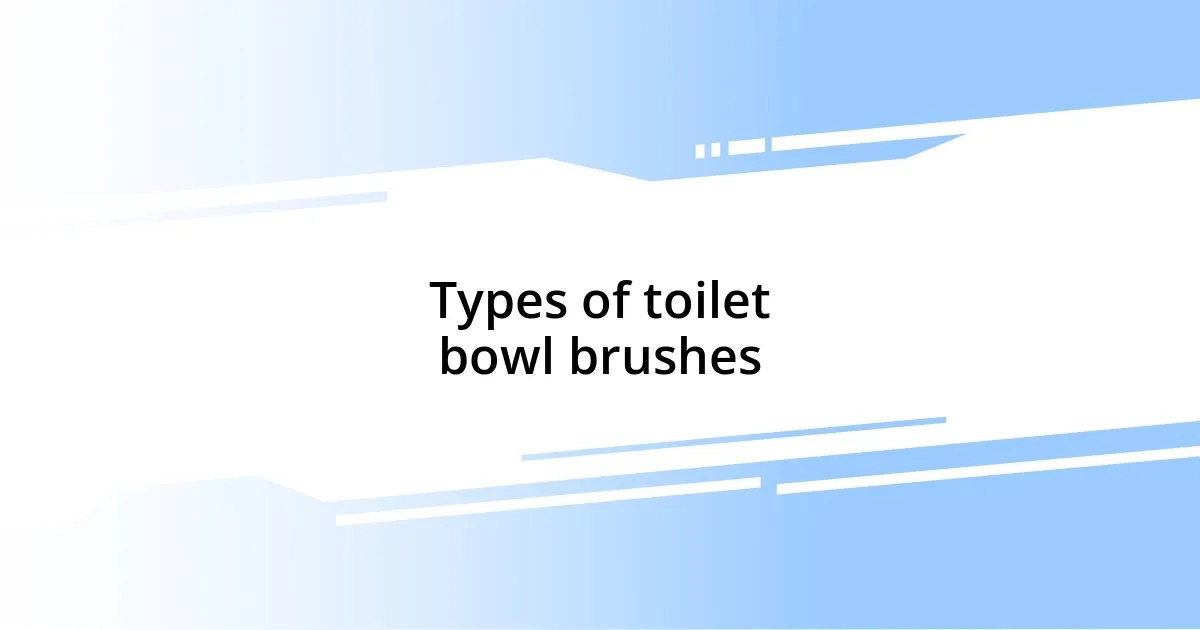
Types of toilet bowl brushes
When it comes to toilet bowl brushes, there are a few primary types to choose from, each with its unique benefits. I’ve found that traditional bristle brushes are the most common and effective, thanks to their sturdy nylon bristles, which can tackle tough stains like a champ. However, there’s something to be said for silicone brushes—they’re gentler on the toilet but still effective, and I appreciate that they often don’t harbor bacteria like their bristled counterparts.
Additionally, I’ve come across disposable toilet brushes that offer convenience but can be a bit wasteful. I remember using one during a quick clean before guests arrived. It was super easy to use, but I couldn’t help but think about the environmental impact. Wouldn’t it be great if we could have a more sustainable option that still delivered that same level of convenience? It’s a balancing act between ease and eco-friendliness that I often ponder.
Lastly, there are electric toilet bowl cleaners available that do the scrubbing for you. When I first tried one, I was skeptical, thinking it wouldn’t clean as well as doing it manually. But I was surprised—it actually made my cleaning routine more efficient. The convenience they provide might just save precious time, especially during those hectic weeks!
| Type of Brush | Advantages |
|---|---|
| Traditional Bristle Brush | Effective for tough stains; durable |
| Silicone Brush | Gentler; resistant to bacteria |
| Disposable Brush | Convenient for quick cleans |
| Electric Cleaner | Efficient and time-saving |

Features of an effective brush
An effective toilet bowl brush boasts several essential features that make cleaning easier and more thorough. From my own experience, I’ve found that a good brush should have a comfortable grip; it makes a world of difference when you’re scrubbing away. I remember the struggle of using a slippery handle after a few minutes of cleaning—talk about frustrating!
When considering the design of an effective brush, here are some key features to look for:
- Sturdy bristles: They tackle tough stains without damaging the toilet surface.
- Ergonomic handle: A comfortable grip reduces strain during scrubbing.
- Durable materials: Look for brushes made from high-quality nylon or silicone to resist wear and tear.
- Quick-drying holder: A holder with ventilation prevents mold and odors.
- Easy to clean: Brushes that can be washed or sanitized ensure hygiene.
Each of these factors contributes to a more efficient cleaning experience. For instance, I used to underestimate how much easier scrubbing could be with a well-structured handle. Once I swapped out my old brush for one designed with these features, I not only completed the task faster, but I also felt proud of the results. It’s amazing what the right tools can do!
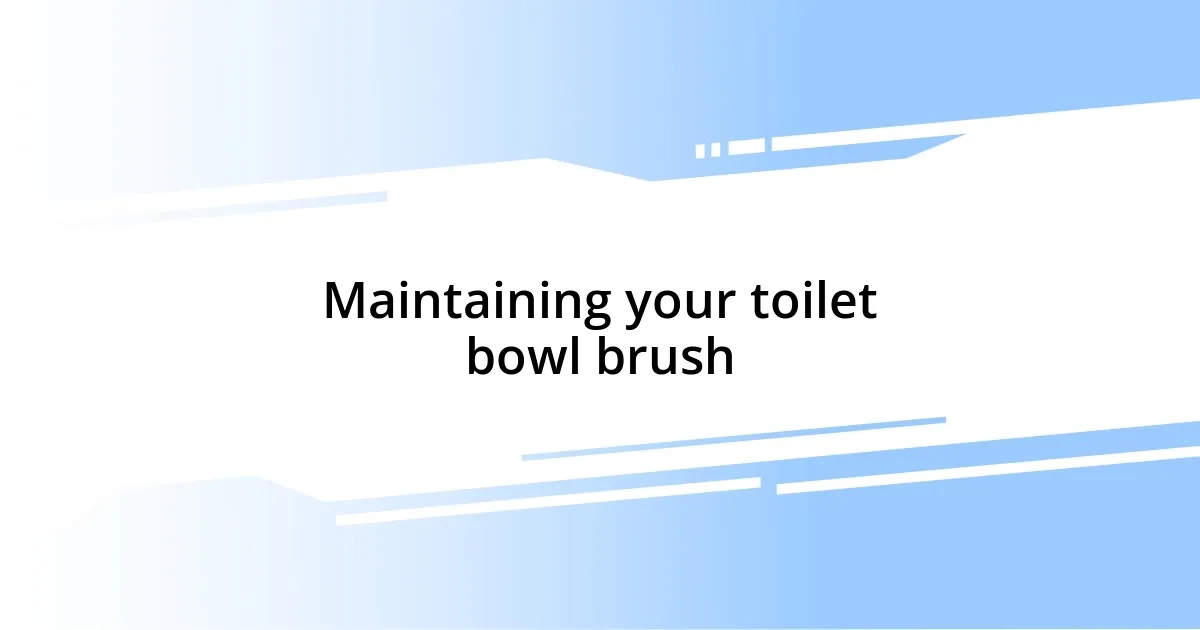
Maintaining your toilet bowl brush
Maintaining your toilet bowl brush is crucial for both hygiene and longevity. After each use, I rinse my brush under hot water and give it a good shake to remove excess water. This simple act has made a noticeable difference—I no longer feel the dread of reaching for a damp brush that could potentially harbor bacteria.
I’ve also found that keeping the holder clean is just as important. Once a week, I take a moment to wipe down the inside of the brush holder with a disinfectant. Believe me, the first time I did this, I was shocked by how much residue had built up. It’s easy to forget that even the tools we use for cleaning can get grimy!
Finally, I recommend replacing your toilet brush every six months to a year, even if it still looks okay. I often think about the time when I held onto an old brush for too long—what a mistake! The bristles were splayed, making it less effective. It’s a small investment for a big gain in cleanliness; trust me, you’ll notice the difference right away.
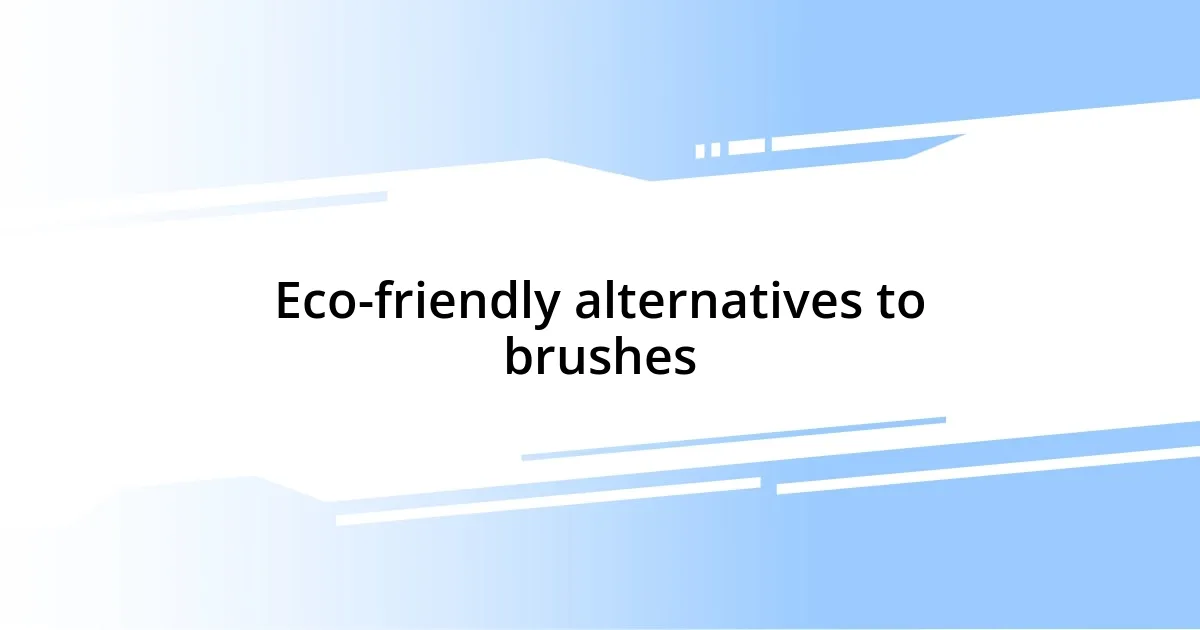
Eco-friendly alternatives to brushes
One interesting eco-friendly alternative to traditional toilet bowl brushes is the use of biodegradable cleaning tools, such as plant-based fiber brushes. These brushes break down quickly and safely after disposal, which gives me peace of mind knowing I’m not contributing to plastic waste. It’s almost like swapping out an old friend for a new one—same purpose, but a much better impact on the environment!
I’ve also come across some incredible DIY options that are both effective and budget-friendly. For example, old toothbrushes can be repurposed as toilet bowl scrubbers. I remember the first time I did this; it felt like a “light bulb” moment. Not only was I saving money, but I was also giving new life to something that would have otherwise ended up in the trash.
Lastly, consider exploring reusable alternatives like silicone scrubbers or compostable sponges. They may not have the familiar shape of a brush, but they really get the job done! I found that using a silicone scrubber provides the same scrubbing power without the fear of wear and tear like with traditional brushes. Plus, when I’m done cleaning, I can just toss it in the dishwasher—how convenient is that?







